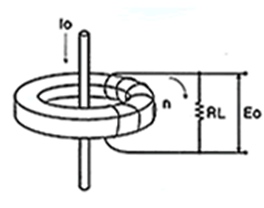INDEX
■ Function
The heater burnout alarm function uses a dedicated current detector to detect the load current, and if the control output is lower than the current value set at ON, it is determined that the heater is burnt out and the alarm contact is turned ON.
Furthermore, if the current value becomes higher than the set value while the OFF signal is being output from the controller (such as a short-circuit failure of the relay or SSR), it is determined that the actuator has failed and the alarm contact is turned ON.
■ Principle (current transformer method)
This is a current transformer with n: 1 current transformer ratio between the n-turn secondary winding wound on the ring core and the through wire. The output current is converted to a voltage signal by flowing it through a load resistor.
■ Structure (current transformer method)
This is a structure in which an insulated CT (Current Transformer) with a toroidal winding applied to the ring core is epoxy-encapsulated in a plastic case.
The secondary winding is connected to a lead wire or pin fixed to the case, and is insulated from the through wire.
■ Notes
● The current detector (CT) monitor value is only a guide. If power fluctuations are large, a smaller value must be set.
● When multiple heaters are connected in parallel, it is necessary to set a larger value (within the current monitor (CT) monitor value) to increase the sensitivity.
● If the heater break alarm function is set and the current detector (CT) is not connected, the heater break alarm will turn ON.
